Albert Einstein, What Was He Thinking?
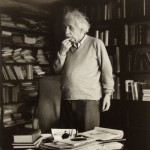
“When I examine myself and my methods of thought, I come to the conclusion that the gift of fantasy has meant more to me than any talent for abstract, positive thinking.” ~ Albert Einstein
In the Spring of 1955, when Albert Einstein passed away, he was in his mid seventies. Eventually, it was discovered that the pathologist who performed the autopsy snuck away with Einstein’s brain in a jar. Everyone wanted to know what went on in the mind of this phenomenal and idiosyncratic genius, and someone was apparently willing to risk his career and reputation to find out. Within a few years, slices and slivers of this famous brain were in the secret possession of an unknown number of, most likely salivating, curious brain researchers. In 1978 a research journalist located the pickled brain and what remained of it was handed over in a Tupperware container to the University Medical Center at Princeton and the research continued.
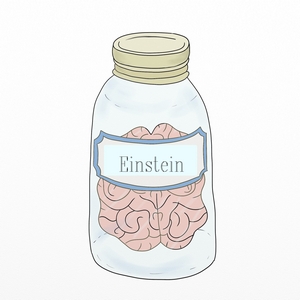 What they had previously found was that his brain was basically normal. It had the same amount of neurons as most brains they claimed. What was notable then was that the two hemispheres were thought to be symmetrical, which can relate to being ambidextrous. Although Einstein wrote with his right hand, there are arguments for the possibility he was switched from being left handed to right as a child. This was a trend at the time. In the hands, there are a few markers to look for when trying to decide if someone is left or right hand dominant.
What they had previously found was that his brain was basically normal. It had the same amount of neurons as most brains they claimed. What was notable then was that the two hemispheres were thought to be symmetrical, which can relate to being ambidextrous. Although Einstein wrote with his right hand, there are arguments for the possibility he was switched from being left handed to right as a child. This was a trend at the time. In the hands, there are a few markers to look for when trying to decide if someone is left or right hand dominant.
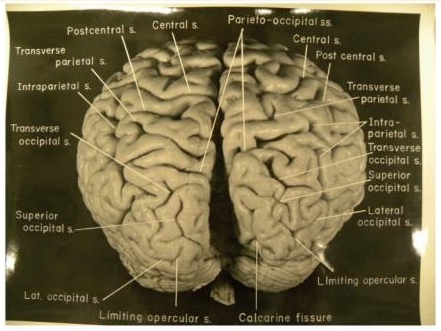
“Imagination is more important than knowledge. For knowledge is limited to all we now know and understand, while imagination embraces the entire world, and all there ever will be to know and understand.” ~ Albert Einstein
When I look at a brain I think immediately how similar the intricate rows of sulci and gyri are to the ridges and furrows on the palms and soles. Since the early days of the computer, hand analysts have been claiming the hand is a print-out of the brain’s computer. In another article I have written about how the nervous system is an important and influential aspect in the initial development of the ridges.
Although scientists have taken his brain apart and studied it with the latest technology, unless you can interpret the scientific jargon in the report and are able to relate the different sections of the brain to behavior and cognizance, along with knowing what normal and abnormal relate to, you probably still wonder what is behind the genius of Einstein. An interesting find was that rather than having more neurons, there were instead a greater amount of glial cells. This is the material the neurons are packed in. What researchers discovered was the communication between these cells and their control over the neurons. It appears the glial cells were listening to the communications among the neurons and made associations at another level. Einstein apparently had more of the cells that give us the “ah ha” moments.
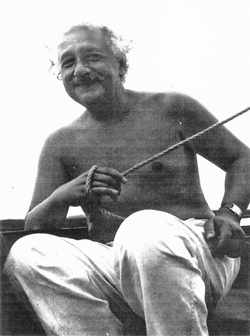
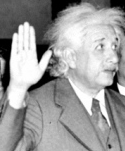
Albert Einstein’s Right Hand
Albert Einstein’s Left hand
“If a cluttered desk is a sign of a cluttered mind, of what, then, is an empty desk a sign?” ~ Albert Einstein
Fine lines criss cross the palms in all directions forming large and small grids. This shows a very busy, detailed and analytical mind. The chaotic nature of the fine creases is reflected in the apparent disorder on his desk.
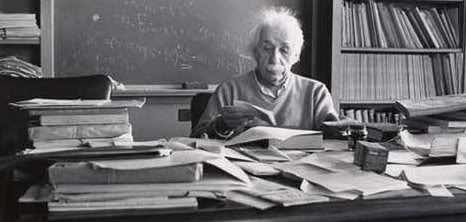
The book “A Perfect Mess,” by Eric Abrahamson and David H. Freedman, describes the method behind the madness. “Mess isn’t necessarily the absence of order. A messy desk can be a highly effective prioritizing and accessing system. In general, on a messy desk, the more important, urgent work tends to stay close by and near the top of the clutter, while the safely ignorable stuff tends to get buried to the bottom or near the back, which makes perfect sense. The various piles on a messy desk can represent a surprisingly sophisticated informal filing system that offer far more efficiency and flexibility than a filing cabinet could possibly provide.”
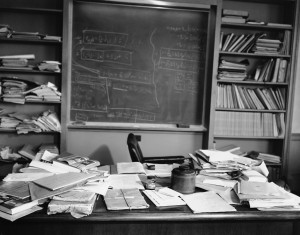 Of course, I’m quite proud to say I have some things in common with Einstein, too… for instance his filing system. Click on the photo for a closer look at the details of his desk, as it was left at the Institute for Advanced Study, when he passed away. There are bundles and packets of papers tied with string and calculations on a chalkboard. What is most remarkable to me is that there are few books on the shelves or his desk. Mostly papers, files, and folders filled with his vast collection of information. Frozen there in the photos of a cluttered desk might be found a piece of the mind of Albert Einstein. I had to wonder if he knew of his impending death and everything on the desk was in intended order.
Of course, I’m quite proud to say I have some things in common with Einstein, too… for instance his filing system. Click on the photo for a closer look at the details of his desk, as it was left at the Institute for Advanced Study, when he passed away. There are bundles and packets of papers tied with string and calculations on a chalkboard. What is most remarkable to me is that there are few books on the shelves or his desk. Mostly papers, files, and folders filled with his vast collection of information. Frozen there in the photos of a cluttered desk might be found a piece of the mind of Albert Einstein. I had to wonder if he knew of his impending death and everything on the desk was in intended order.

“The intuitive mind is a sacred gift and the rational mind is a faithful servant. We have created a society that honors the servant and has forgotten the gift.” ~ Albert Einstein
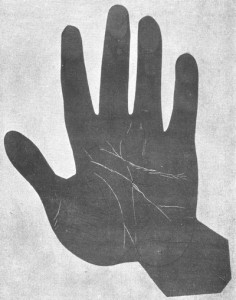 Albert Einstein’s Right Hand – “Secrets of Hand Reading” Noel Jaquin (1934)
Albert Einstein’s Right Hand – “Secrets of Hand Reading” Noel Jaquin (1934)
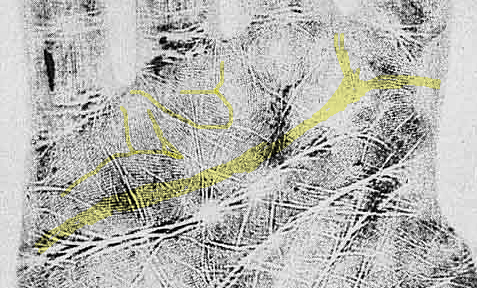
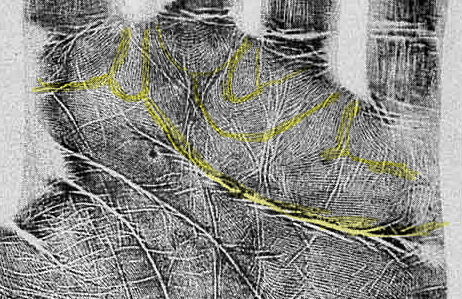
The main lines in the hands are formed by tracing the radiants or one of the three ridges that flow from the triradii under the fingers. The ridges are not sharp in these prints, but enough of the flow of ridges is visible to be able to identify the general direction they move and the location they leave the palm. I have traced them in a general way, leaving out the ridges that were not clearly visible.
Typically the main line from under the index finger, known as Main Line A, ends on average right about where Einstein’s ends. Usually the non-dominant hand’s main line moves farther down into the palm than in the dominant. It appears that both main lines end at about the same location. This is fairly common on people who claim to be ambidextrous.
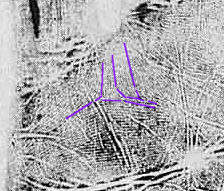 In this close-up of the left interdigital area between the ring and little fingers there is the appearance of a vestigial loop. This is formed by a convergence of ridges in a portion of the interdigital IV zone. A complete loop here, when found, is considered to relate to a person’s ability to grasp things. They tend to have a witty mind and their own special kind of humor. A vestige is a formation that is incomplete or a unique disturbance in the flow of the rows of parallel ridges. People with an unusually formed pattern in this area tend to relate to the experience of having themselves find humor in places not noticed by others. Laughing out loud alone in the theater might be a common trait.
In this close-up of the left interdigital area between the ring and little fingers there is the appearance of a vestigial loop. This is formed by a convergence of ridges in a portion of the interdigital IV zone. A complete loop here, when found, is considered to relate to a person’s ability to grasp things. They tend to have a witty mind and their own special kind of humor. A vestige is a formation that is incomplete or a unique disturbance in the flow of the rows of parallel ridges. People with an unusually formed pattern in this area tend to relate to the experience of having themselves find humor in places not noticed by others. Laughing out loud alone in the theater might be a common trait.
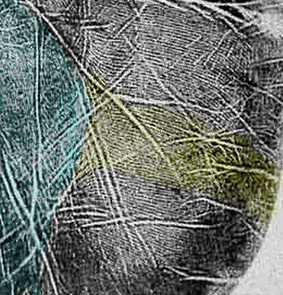 On the hypothenar, or moon area of Einstein’s right palm, there is a configuration that very closely resembles the column or comb vestige. This is a formation where rows of horizontal ridges meet vertical ridges surrounding the thenar, or Venus, mount. People with this arrangement of ridges in this area of the palm tend to have particularly organized minds. They are very good at linear thought or being able to scan through their brains for the information they seek, like it’s filed on a shelf in their brain.
On the hypothenar, or moon area of Einstein’s right palm, there is a configuration that very closely resembles the column or comb vestige. This is a formation where rows of horizontal ridges meet vertical ridges surrounding the thenar, or Venus, mount. People with this arrangement of ridges in this area of the palm tend to have particularly organized minds. They are very good at linear thought or being able to scan through their brains for the information they seek, like it’s filed on a shelf in their brain.
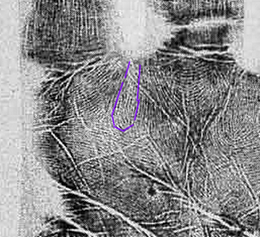 Einstein was Jewish. From the many bar and bat mitzvah’s I’ve read hands at, I can attest to the fact that the raja loop, or interdigital loop between the index and middle fingers, is more commonly found on those with Jewish ethnicity. So is finding patterns between all the four fingers. An aura of charisma and charm often surrounds the owners of these raja loops. This loop forms on the same mount (the Mount of Jupiter) that the Ring of Solomon and Empathy lines appear. Einstein has a trace of these lines.
Einstein was Jewish. From the many bar and bat mitzvah’s I’ve read hands at, I can attest to the fact that the raja loop, or interdigital loop between the index and middle fingers, is more commonly found on those with Jewish ethnicity. So is finding patterns between all the four fingers. An aura of charisma and charm often surrounds the owners of these raja loops. This loop forms on the same mount (the Mount of Jupiter) that the Ring of Solomon and Empathy lines appear. Einstein has a trace of these lines.
“How strange is the lot of us mortals! Each of us is here for a brief sojourn; for what purpose we know not, though sometimes sense it. But we know from daily life that we exist for other people first of all for whose smiles and well-being our own happiness depends.” ~ Albert Einstein
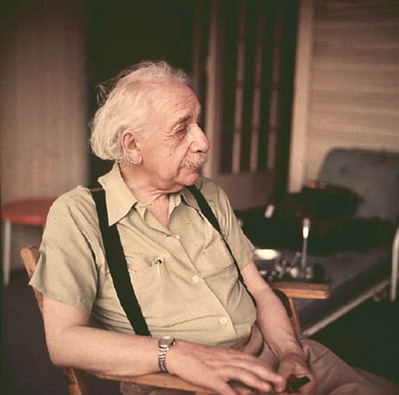
“Isn’t it strange that I who have written only unpopular books should be such a popular fellow?” ~ Albert Einstein
A noticeable feature in Einstein’s hands are the many fine and deep creases. The photos show full based palms and thick, sausage-like fingers. He was a man of very deep emotional feelings. He experienced life strongly through emotions and sensations of empathy. People with thick middle sections to their fingers have good listening skills. They tend also to be magnets of people looking for a listening ear.
“He who joyfully marches in rank and file has already earned my contempt. He has been given a large brain by mistake, since for him the spinal cord would suffice.” ~ Albert Einstein
In each hand, the head line starts out clearly separated from the life line. This feature represents independent thinking. Here is a person who is not naturally of the herd mentality, but rather someone who follows their own path in life. There are no strong vertical lines under the index finger, so leading others isn’t an interest either. He’s going his own way, following his own star, and if you wish to follow down the path, you may. The right head line starts out clear and stays that way until past the middle finger. This shows alert clear thinking from the start. He may appear absent minded and lost in thought, but he hasn’t lost the initial thread of the topic of the moment. Starting out straight shows an initial effort toward clear, practical, and meaningful thought. As the crease bends downward under the ring finger it becomes illustrative of an abstract, dreaming, and creative mind.
“I think and think for months and years, ninety-nine times, the conclusion is false. The hundredth time I am right.” ~ Albert Einstein
Long middle sections to his fingers show a love of detail and spending time planning, organizing and thinking things through. Combine these with the long head lines with their forks and branches and you have the ingredients for a person who has a patient mind and doesn’t like to be rushed to conclusions.
“I hate crowds and making speeches. I hate facing cameras and having to answer to a crossfire of questions. Why popular fancy should seize upon me, a scientist, dealing in abstract things and happy if left alone, is a manifestation of mass psychology that is beyond me.” ~ Albert Einstein
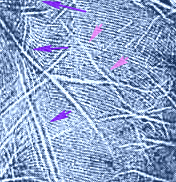 Pink arrows on the right hand point to a crease that floats at the end of the head line, running parallel to the downward branch. Since it’s disconnected, it shows the ability to disconnect from the world once he is deep thought. This line is often on people who either daydream or meditate frequently, or both. You’ll find it, also, on the hands of those who can get lost for hours in video games. It’s a good ability to have when you need to concentrate in a place with a lot of activity and movement going on around you.
Pink arrows on the right hand point to a crease that floats at the end of the head line, running parallel to the downward branch. Since it’s disconnected, it shows the ability to disconnect from the world once he is deep thought. This line is often on people who either daydream or meditate frequently, or both. You’ll find it, also, on the hands of those who can get lost for hours in video games. It’s a good ability to have when you need to concentrate in a place with a lot of activity and movement going on around you.
The purple arrows point to a fragmented Sun Line, also called a Line of Apollo. This is a crease that runs down into the palm from under the ring finger. It would show that Einstein put effort into developing his natural skills and gifts. It is made up of dual creases running side by side. At the head line it changes direction aiming to the outer corner of the palm. This is the area of the subconscious and abstract thinking. His work was as much a hobby as it was his profession. He was gifted in a number of ways. The blue arrow at the top of the Sun Lines points to a spraying of creases aiming upward toward the finger. This shows a pleasure in giving and presenting. He gave of himself because it gave him pleasure, not with expectations in return from those to whom he gave, nor because of their expectations.
“I am neither especially clever nor especially gifted. I am only very, very curious.” ~ Albert Einstein
The narrow space between the head and heart lines, under the middle finger, shows that he didn’t like to compromise when it came to his principles and values. He also didn’t like to find himself in situations where other people’s efforts, that may not be to his standards, would reflect back on him. This works in combination with the independent head lines.
“The ideals that have lighted my way and time after time have given me new courage to face life cheerfully, have been Kindness, Beauty and Truth.” ~ Albert Einstein
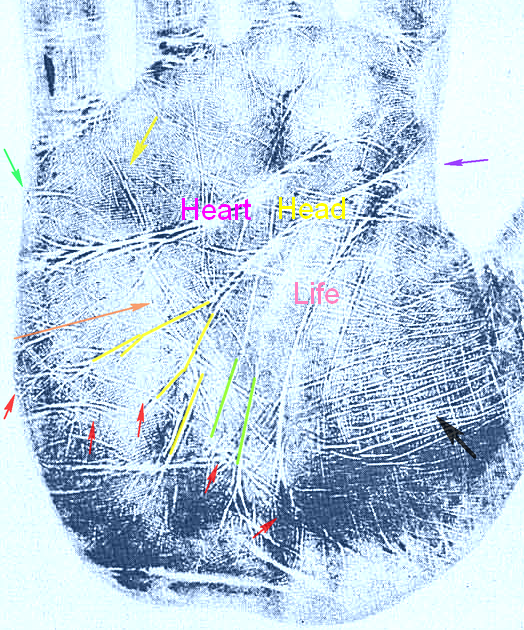 The healer’s marks (yellow arrow) are vertical lines under the little finger. These are on people who are sensitive to their environment and the energy of the people who occupy that space. They relate to a form of empathy. These lines in Einstein’s palm connect to his own Mercury or health lines (pointed to in orange) which continues in an almost straight fashion down the palm. This combines several energies. These health lines illustrate a mind-body connection. Strong gut feelings. The healer’s markings connecting with them would show a very physical source of intuition. Along with the previously mentioned raja loop, this would show a strong ability to read people and the environment in a very physical and mentally intuitive way. He would feel compelled to fix or correct things. If he were in the medical profession, it would be healing related, but for him it was understanding the universe by fully comprehending it.
The healer’s marks (yellow arrow) are vertical lines under the little finger. These are on people who are sensitive to their environment and the energy of the people who occupy that space. They relate to a form of empathy. These lines in Einstein’s palm connect to his own Mercury or health lines (pointed to in orange) which continues in an almost straight fashion down the palm. This combines several energies. These health lines illustrate a mind-body connection. Strong gut feelings. The healer’s markings connecting with them would show a very physical source of intuition. Along with the previously mentioned raja loop, this would show a strong ability to read people and the environment in a very physical and mentally intuitive way. He would feel compelled to fix or correct things. If he were in the medical profession, it would be healing related, but for him it was understanding the universe by fully comprehending it.
“The most incomprehensible thing about the world is that it is comprehensible.” ~ Albert Einstein
The heart line bends down at its end and touches the life line. This is often on people who have gone through an experience early in life where they have had their ‘bubble burst’. In the right hand, the heart line has faint branches that want to aim up to the index finger. This would show a natural ability to trust and perhaps to be idealistic. When this crease bends down strongly, it shows its owner has learned early that they must rely more on trusting themselves and not on others.
In books about hand anatomy, it is stated that the coming together of the heart, head, and life lines, indicate a stronger hand grip, particularly in males. This can also be symbolic of being forced to get a strong grip on life and reality.
“The intuitive mind is a sacred gift and the rational mind is a faithful servant. We have created a society that honors the servant and has forgotten the gift.” ~ Albert Einstein
The yellow and green color can be seen to form a fanning out of the creases while they aim to the bottom outer corner of the palm. The fate (green) and head line endings all fan in a parallel fashion. This shows both a reaching down into the depths of the soul as far as one can go, and at the same time the ability to bring back to the conscious world the results of both productive activity and insight. Like roots.
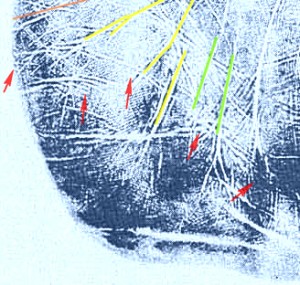 Creases that arc from near the wrist on the thumb half of the hand, and rise in a big curve over to the percussion, I call the Star Trek Line. These creases form on people that enjoy thrills and desire to go where no one has gone before. It’s beyond just a pioneer spirit as this energy is more about fearlessness and thrills. People in power tend to have these markings, along with those who enjoy x-sports. In older palmistry books, this formation (red arrows) has been referred to as the via lascivia regarding a passion for gratifying physical desires.
Creases that arc from near the wrist on the thumb half of the hand, and rise in a big curve over to the percussion, I call the Star Trek Line. These creases form on people that enjoy thrills and desire to go where no one has gone before. It’s beyond just a pioneer spirit as this energy is more about fearlessness and thrills. People in power tend to have these markings, along with those who enjoy x-sports. In older palmistry books, this formation (red arrows) has been referred to as the via lascivia regarding a passion for gratifying physical desires.
When his wife asked him to change clothes to meet the German Ambassador: “they want to see me, here I am. If they want to see my clothes, open my closet and show them my suits.” – Albert Einstein
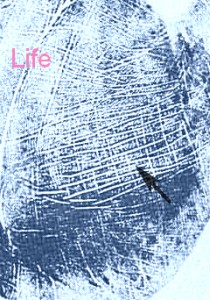 The lines that radiate out from the thumb show a sensitivity to picking up on what other people project at them. The more these creases cross the life line the more a person cares what some one else thinks. This energy also increases with these lines rising toward the fingers, especially in the direction of the little finger. Once they begin to aim downwards, the person has shifted toward having people around them that care more about what he thinks than he cares about what they think.
The lines that radiate out from the thumb show a sensitivity to picking up on what other people project at them. The more these creases cross the life line the more a person cares what some one else thinks. This energy also increases with these lines rising toward the fingers, especially in the direction of the little finger. Once they begin to aim downwards, the person has shifted toward having people around them that care more about what he thinks than he cares about what they think.
The vertical creases that make up the grid effect across the entire thenar mount represent blocks to the free flow of the radiating lines mentioned above. Like inner walls. This grid of lines appears on people who like to challenge and debate things. The combination of the grid pattern here and whorls on both thumbs would increase the enjoyment of playing devil’s advocate and debating for the fun of it.
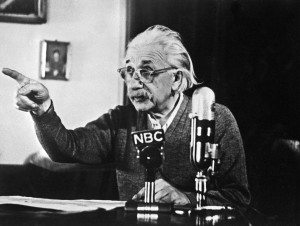
“The important thing is not to stop questioning. Curiosity has its own reason for existing.” ~ Albert Einstein
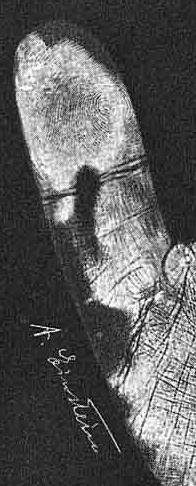 Einstein had seven of his finger prints as whorls. People with many whorls tend to love research and studying. They are very curious and tend to delve deeply into whatever they are involved in. Another quality of those with these concentric or spiral circle finger prints is the ability to easily make associations and connect the dots. I wonder if most people with these whorl patterns have more glial eavesdropping on the neurons in their brain tissue…
Einstein had seven of his finger prints as whorls. People with many whorls tend to love research and studying. They are very curious and tend to delve deeply into whatever they are involved in. Another quality of those with these concentric or spiral circle finger prints is the ability to easily make associations and connect the dots. I wonder if most people with these whorl patterns have more glial eavesdropping on the neurons in their brain tissue…
His right middle finger had a loop pattern. This would stand out in the midst of the whorls as different and therefore stand out in his personality. The loop here would allow a flexibility in seeing that other people had different backgrounds and perspectives than his own.
His thumbs are thick and a bit stubby, although not particularly short. There appears to be a balance between being willful and rational. The thicker lower section would show a bluntness in his speech, saying what he thought without worrying too much about diplomacy.
As much expected, the features in Albert Einstein’s hands very closely match his ideals shared in quotes collected over his lifetime. It’s beyond the scope of this blog post to do a complete hand reading, which is also limited by the poor quality of prints available. However, I do hope this bit of analysis arouses curiosity into the world of reading hands.
What was Einstein thinking? From reading his palms, I think he was a free spirited person with the great ability to use his imagination and sensibilities to their fullest. He never stopped exploring the outer reaches of his mind or the inner reaches of his soul. A book on philosophy lay on his desk at the end of his life, at the top of the stack and close at hand.
“Life is like riding a bicycle. To keep your balance you must keep moving.” ~Albert Einstein
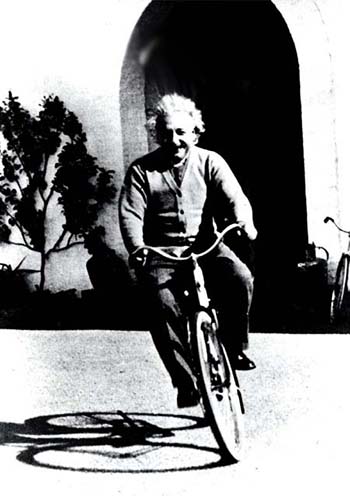
As always, your comments are welcome below.
in joy and peace,
Patti Lightflower
Post Blog Post: Coincidentally, as I finished writing this I discovered a Facebook friend had just shared a wall post saying that the huge hand print collection of Marianne Raschig, including Albert Einstein’s, will go on auction at Sotheby’s in London on June 5 and 6!! How cool is that!? The prints below are a much truer representation of Einstein’s hand shape than those that have been floating around the internet scanned from the book. Especially interesting to note will be the size of his fingers here as compared to the other images available. I can’t wait to see what kind of bids will be offered and who will be the chirology connoisseur that has the winning bid! Click on the photo for a link to the article.
Looking at these prints side by side, you can see the right head line is much cleaner and sharper than the one on the left all the way to the end. The heart line has more feathering in the left hand showing emotional and personal aspects of his personality. These are just a couple of things that support that Einstein favored using his right hand and I would read him as right hand dominant.

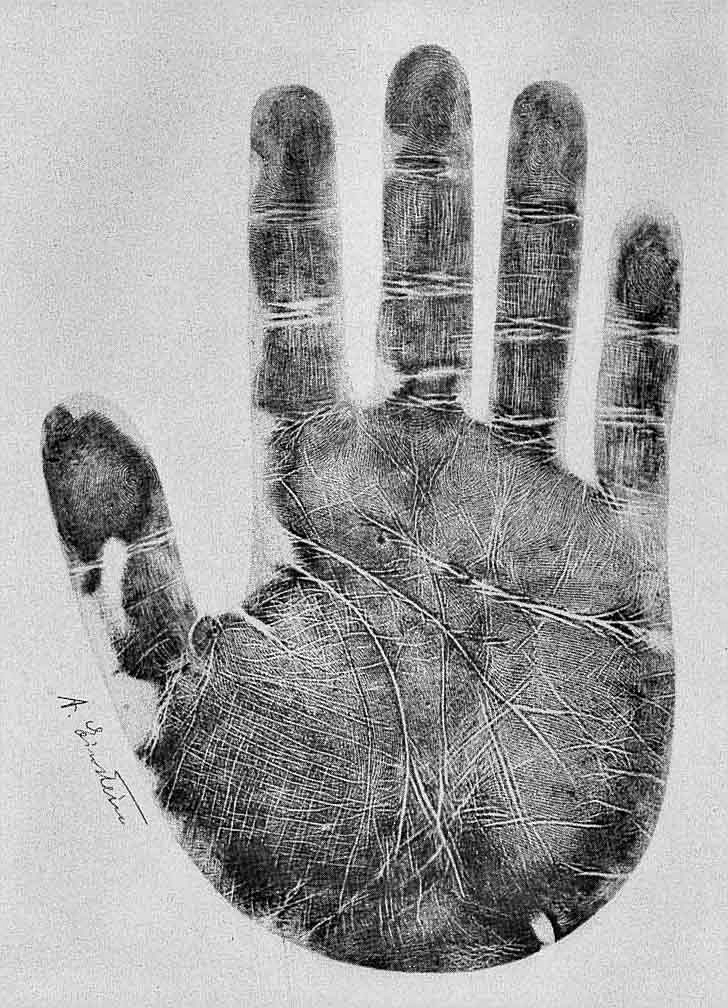
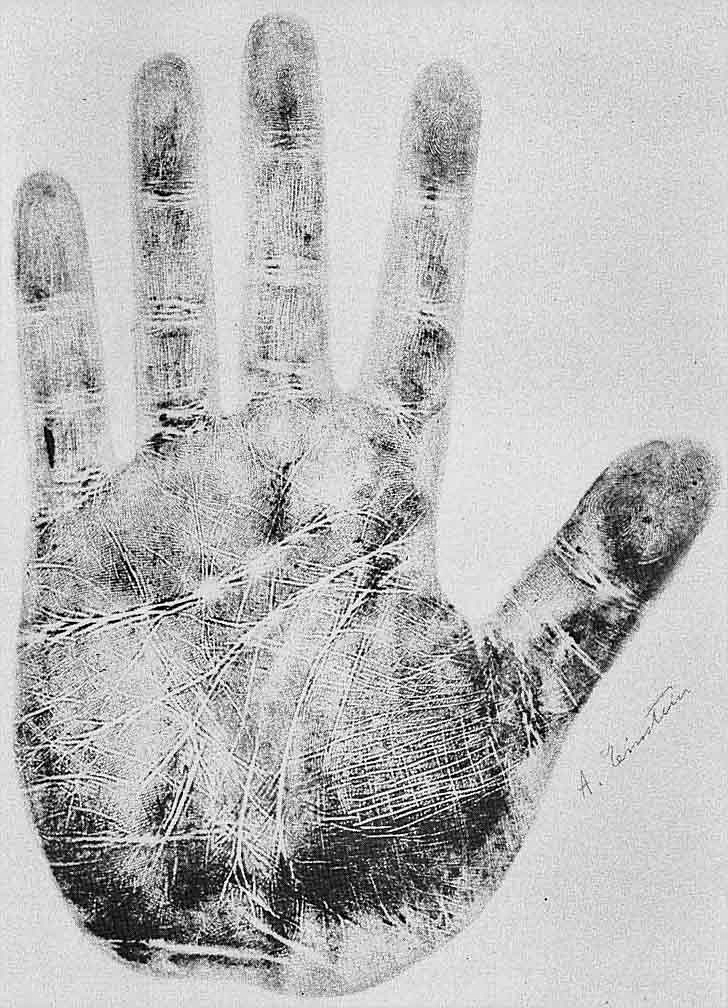
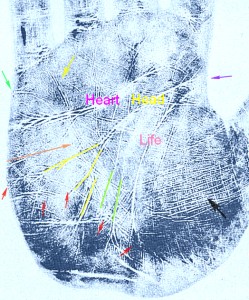
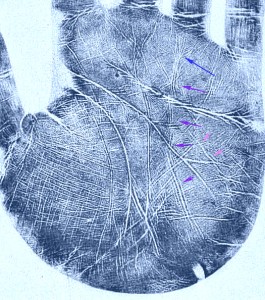
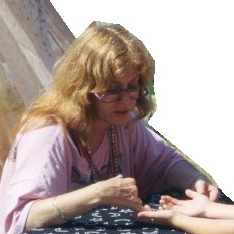
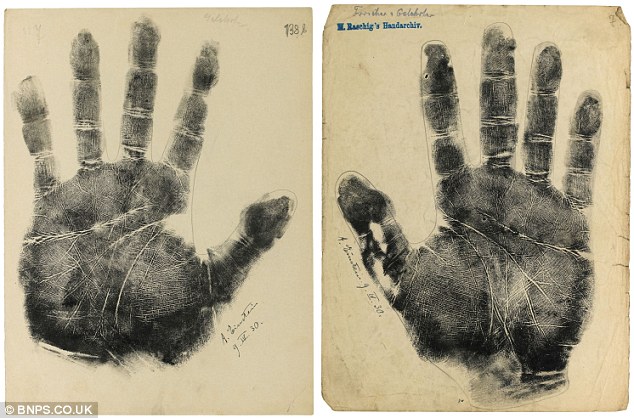
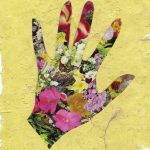
Beautiful and clear prints. Good analysis backed by incidents of life. Patti , you have done a marvelous analysis. Thank you very much.
Thank you Anthony for taking the time to read my blog and for your kind and encouraging words! 🙂
My favourite blog post so far, what a gem! And not just because I’m a fan of old Albert … I love everything about it, from the way you tied in all his quotes, to the helpful illustrations of his prints, to your succinct and cohesive analysis. I’ve spent many an hour poring over his prints, myself, but was miles away from getting anything as poignant. Thanks, Patti!
Thank you so much Romy! In a way this piece guided itself, I had another direction in mind originally. The quotes in the beginning were just meant as ‘eye candy’ between thoughts, but soon they seemed like a form of feedback to what I had just written or was about to write. 🙂
I enjoyed your very thorough and well illustrated analysis. There is one point that I’d like to challenge. You mention that the strongly developed middle phalanges of his fingers suggest a love of detail. I think Einstein’s intuitive shaped hands and widely separated head and life lines suggest a dislike of detail. He had the capability, but not the patience for detail. Although Einstein is best known for his theory of relativity, it’s the theory part that mattered to him. His wife, a master mathematician, worked out the detail (though she didn’t get the credit).
Hi Mark!
Thank you!
I accept your challenge and agree with you! I should have realized all those orderly file folders on labeled shelves, in some photos on the net, were not so neatly done by him. I saw it as a contradiction to the messy desk, messy mind perspective when considering the long head lines and long middle section of the fingers.
But, my justification was related to memories of my relatives on my birth mother’s side of the family. Orthodox Jew with the fleshy palms, thick fingers and emotional creases. Many years ago an elderly aunt asked if I would come and help her clean her house. A hallway had newspapers stacked in piles from one end to the other along one wall. I thought that was a good place to begin throwing stuff out. But I was wrong. This was her calendar. Important papers were mixed throughout the newspapers and easily found (by her) by the date of the paper. There had to have been a few years stashed there and she knew what was where. Looked like a fire hazard to me.
Her brother, my grandfather, an ophthalmologist, never had a receptionist or secretary and all the patient’s files were kept about like Aunt Ann’s newspapers, in piles. He could always walk right to the one he needed and pull it out. When I took my son as a toddler to visit at their home, he wasn’t allowed near the stairs, not because he might get hurt, but on each step going upstairs were various important papers and odds and ends. It looked like clutter to me, but the order of things as they were seemed sacred to them.
So yes, I’d agree, he probably didn’t like tedious details, like filing and ordering things. But, I think that in what appears like chaos to us, there is perfect order to him. One of his quotes mentioned thinking for months and years over a problem and then coming to the correct answer. Obsessing over that kind of detail might be how he expressed this energy. Also, I would see it in how he said he didn’t like crossfire questions, which would require being able to respond somewhat on impulse. Yet, contradicting that is his statement that everything should be made as simple as possible.
I appreciate that you read my article and your supportive words, Mark! Thank you for your input and the opportunity to add more clarity!
Really well done! Thank-you so much for sharing. I like the cluttered mine analogy. 🙂
*mind*
Thank you Brent! 🙂 I enjoyed that quote about the organized clutter on a messy desk, too. It’s exactly how mine becomes. It’s always interesting, when I take the time to clear the space, what I find at the bottom of the piles at the back.
p.s. I just checked out your link! What an awesome project!!
Hi Patti
I liked the way you have started of describing about Einstein, his room, the way he is and then started describing about his hands. It is very good pic you have taken, the interesting thingh every body could relate to some feature in Einstein hand (not all ofcourse), like the example of vestige, loops, whorls, finger shape, lines. and his hand can be given as a good example for understanding too, as it has lot of interesting features. From that point I think there will be lot of people interested in reading this article and hence understanding different hand features.
Great work, and great information and sound analysis, I liked your analysis on vestige pattern meaning, comb in mercury,comb meaning in hypothenar, information on independent head lines, loops in middle finger, healer mark ( something new I learnt), loops in palm, main lines difference and its relation to being ambidextrous, also I liked the way you have analysed about lines in thenar mount it is a new approach.
Great information and great work.
Iam not able to see some images, probably there is some browser problem
Anand
Thank you Anand! And thank you for asking me to take a look at Einstein’s dermatoglyphics because you thought he might have a vestigial loop! You triggered the inspiration!
Patti, wonderful analysis and information.
Thanks and regards
Thank you Sachindra!
Hi Patti
Thanks for considering my thought on vestigial loop in Einstein hand and thank you for considering my observation for the inspiration aspect. Very generous of you to write based on these observations.
I hope people will understand more about vestige and other dermatoglyphic features, importance of lines , dermatoglyphics and the way it has to be analysed to get a holistic view of palmistry for which your blog would play an crucial role. In short this is like teaching others on the subject.
Hope for more interesting and popular prints can be discussed here.
Anand
Well done patti for the essay!
What feature of his hand representing him as a ‘special’ individual in science?
can we find celebrities through palm?
These are the questions much likely risen by modern scientists or researchers or sceptics. Sun line, partial ring of solomon?, whorl in many fingers(7), These features can be even found in the hands of ordinary man . do you agree with me? so, what feature in his hand representing him “special”?
Second phalanges of finger represents materialistic aspect if i am right.
grid in mount: isn’t a common feature in venus? is n’t a negative sign? if i am right, we should not seperate vertical and horizontal lines when we qualify it grid. Also, how can a vertical lines here can be called as blocking line . Rather, Horizontal lines are negative sign and vertical lines are positive sign in palmistry. am i right?
writer’s fork: ? how many books did he write except physics theories? Honestly i dont know.
square hand or fire hand? hmm.. He believes in intuition and imagination. so surely fire energy comes to play rather than having interest on details. If he belongs to square, he will not give a bit of way to imagination and intuition.
However, all explained features can be commonly found in ordinary man in our society. That is why peoples call ” palmistry as psuedo science”. To prove that palmistry as science we need to find the specific features of the special peoples who had extra ordinary success in life. This is the only way or proof remain to demonstrate the world ” palmistry as science” . (but so far, noone could prove it likewise) This is one of the leading expectation of palmists. Scientists research on peculiar and uncommon features of einstein’s brain. As a palmists , we have to find the peculiar and uncommon features of einstein’s palm. If we point out exclusively common features of palm in his hand, we cannot make any evolution in palmistry especially in this modern world.
kamala.
Thank you Kamala for your interest and for your questions!
Einstein himself answered many of your questions. He explained over and over that he wasn’t remarkable and didn’t have any special gifts, other than his gifts of fantasy, curiosity, and imagination.
One aspect of the research on his brain also gives a clue to what may be his ‘gift’. He had more glial cells. It is thought that these cells help connect the highlights and main points of random thinking and ideas. He ‘gets it’ a lot more often than the average person. Then I think when he brainstorms about those ‘profound’ insights, the glial cells pull out the cream of the crop again. Who knows how often this is repeated.
Have you ever tried to think of something and racked your brain looking for the memory, a name, a date, a place? Then later in the day when you weren’t thinking about it at all, there’s the answer, vividly clear in your mind. Einstein said that when he needed to figure something out, he would spend relaxing time playing his violin. Then slowly the answers would surely come.
How do we see these things in the hand? What are the ingredients that mix together to give him his uniqueness? There’s a fine line, they say, between genius and madness. I look then for the glitches. We see beautiful hands with perfect lines and flawless ridges, but is the owner more gifted or just more beautiful? Eugenics gave up on the hands years ago as they saw the mix among all walks of man and the special markings in the gifted could also be found in the commoner and those born with birth defects.
I think the key to his genius might be found in the dermatoglyphics and how the creases divide them.
His head line does fork, and he has the straight-ish Mercury Line, which is also known as a mark of the journalist.
My palms tend toward the square shape, especially the left hand and I am a dreamer.
“To prove that palmistry is science we need to find the specific features of the special peoples who had extra ordinary success in life. This is the only way or proof remain to demonstrate the world ” palmistry as science.”
If anthropologists and brain specialists are still searching Einstein’s brain for what stands out as special, I think we’re doing just fine as hand analysts searching his hands.
p.s.:
I read the middle phalange as relating to thinking things through. The proximal phalange is about manifesting these plans into the material world.
If you are looking for a meek, compliant, and congenial personality, then having few or no lines of resistance, might be a good thing. If you choose to stand your own ground and head down your own path behind no one, you may need some inner and outer resistance to stay on that path.
Hello Kamala
I thought of adding some thingh to your question, I also think the combination of finger with various Dermatoglyphics features and lines makes any person unique. Scientifically and statistically researchers would like one part of Dermatoglyphics and do a research and not other part and might neglect line features, so when you combine all these together every individual will come out hence it would be tough to categorize anybody.
Like for example you may not find people with 7 whorls and three loops with also with different palmar dermatoglyphics like raja loop or vestiges and independent head line, also you may not find lot of person with 10 loops with lot of palmar loops and long hands so when we draw all these combinations it would be tough to say that there is a lot of similar features across people, there would be definitely be some difference.
Probably genius is something more than these thinghs, but my thought would be once you combine all features you would find the individual is the way I look at palmistry.
Anand
Great article! got the link to read this article through a forum.
Some interesting alternative views are here.
http://www.mysticboard.com/viewtopic.php?t=82223
Hello patti,
Vestige and comb ridges represent quirk behaviour that you explained in another article. does it applicable to einstein as well? or does he has any peculiar ridges that representing his genius mind?
Hello Munidas,
I mentioned here in this article about what I would read as quirky. It was in regards to the pattern in the space between his ring and little finger.
Hi Patti,
well written. The best part, as is highlighted by many readers in the comments section is the illustrations from the life of Einstein. It helped me to relate the hand features with the real life scenarios.
One more point of highlight is also his regularly set(and not low set) and very long Mercury finger. Look forward for more of such articles.
Thank you Kiran! Agree with the normal setting of his little finger.
Hi Patti
Regarding eisntein left hand, regarding the area between ring and mercury finger, does the main line (from the ring finger triadius) flow towards mercury area and is there an interdigital loop between ring and Saturn in left hand. In the right hand there is interdigital loop between Saturn and ring. Iam just thinking whether there is vestige in that area in left hand.
Anand
I traced the main lines that were visible in examples just under the full prints. I couldn’t see Main Line B from under the middle finger in the left hand, so I didn’t trace it. It most likely ends where it ends in the right hand.
In the left hand Main Line C curves back to in between the ring and little fingers, forming what appears to be a ‘vanity’ loop. In the right hand this same Main Line C from under the ring finger flows to in between the middle and index finger, forming a ‘responsibility’ loop.
I doubt there is a loop between the ring and middle fingers of the left hand. This is because there is already a loop pattern between the little and the ring. Statistically, if there is one loop present, it is less likely there is the other. Of course these two appear at the same time in a person’s hand, just less frequently. Neutralizing that is his ethnic background raising the likelihood of having patterns between all the digits.
Hopefully in the near future we’ll get to see a closer look at the prints that will be auctioned off next week! 🙂
Hi Patti!
Beautiful article! I’m really glad to see you expand so productively and creatively along the lines of this blog. Looking forward to more gems.
Boaz
Thank you Boaz!
another very interesting article 🙂
I didn’t notice this quote which I have on my business cards & website (which I think relates to Einstein’s long headline into luna, as opposed to the shorter straighter headline we usually think of for scientists)
“The most beautiful thing we can experience is the mysterious. It is the source of all true art and all science. He to whom this emotion is a stranger, who can no longer pause to wonder and stand rapt in awe, is as good as dead: his eyes are closed.”
Albert Einstein
http://www.mysticevents.co.uk/
What a fitting and cool quote, Lynn, to relay your field of expertise!
🙂